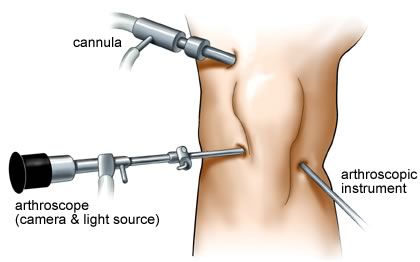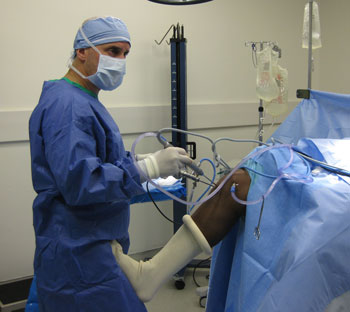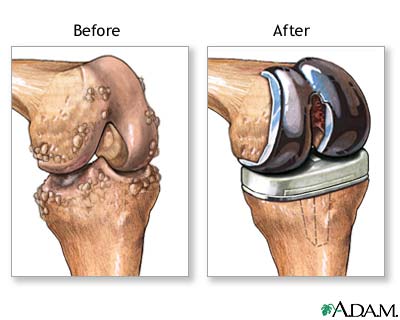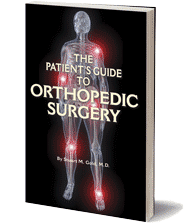Knee Replacement Surgery & Arthroscopic Knee Surgery
By Dr. Stuart Gold, M.D., Orthopedic Surgeon & Author
Whether treating injured sports players or elderly patients with arthritis, the medical field has seen an increase in knee surgeries in recent years. Technological advances have made these surgeries less painful and easier to recover from. Still, many patients may wonder just how much their quality of life will improve if they have knee surgery. The following article discusses two common knee surgeries and ideal candidates for these procedures.
Knee Replacement Surgery
Another common but more invasive procedure is knee replacement surgery. Knee replacement surgery is most often used in patients suffering from painful arthritis, specifically osteoarthritis. Knee replacement surgery either partial or total should only be considered after all other forms of treatment have been exhausted.
- Knee Replacement Risks. Common risks in knee replacement surgery are much the same as the risks in arthroscopic knee surgery. Blood loss during surgery can be more common as it is a more invasive surgery. Blood clots, infection in the knee joint, and stiffness of the knee joint are the most common risks. Finding a qualified surgeon is important in minimalizing risks associated with any procedure.
- Knee Replacement Benefits & Statistics. It is estimated that 90% of knee replacement patients experience improvement in their condition, showing a high success rate for this common surgery. Part of these good results is due to the follow up care and rehabilitation that is necessary immediately following knee replacement surgery. This keeps the knee joint from becoming stiff, therefore causing a lack of mobility. Still, approximately 270,000 of these procedures are performed every year with a very high success rate, making knee replacement one of the more common procedures.

Arthroscopic Knee Surgery
Arthroscopic knee surgery is a minimally invasive procedure commonly used to treat knee injuries such as a torn meniscus (cartilage) and torn ligaments. It can also assist in the treatment of osteoarthritis, a dislocated knee, and sports injuries.
 Dr. Stuart Gold Performs Arthroscopic Knee Surgery
Dr. Stuart Gold Performs Arthroscopic Knee Surgery
Your orthopedic surgeon can help determine if this surgery is right for you.
- Challenges of Arthroscopic Knee Surgery. The history and physical examination usually provides the surgeon with a good idea of the diagnosis; however testing, such as CT or MRI scans are very helpful in order for your surgeon to know more specifically where the problem lies. Arthroscopic surgery requires a surgeon who is very skilled in directing his hand movements with instruments through very small holes, while viewing everything on a monitor. Make sure you discuss his qualifications before your surgery.
- Risks of Arthroscopic Knee Surgery. Since this surgery is minimally invasive, it has fewer risks than some other knee surgeries. However, all surgeries have a certain degree of risk, which must be addressed prior to the procedure. Risks can include complications with anesthesia, blood clots, infections, excess bleeding, scarring, and nerve damage. These may be temporary or permanent, and may cause the knee pain to increase. It is important to keep in mind that these risks are very rare.
- Benefits of Arthroscopic Knee Surgery. Fewer incisions typically mean less bleeding after surgery and a quicker recovery time. There is also a greatly reduced chance of infection at the incision sites. This type of surgery also does not generally require a hospital stay, and the patient can usually go home the same day of the procedure. Less anesthesia is needed, so there are less anesthesia related complications.
- Statistics on Arthroscopic Knee Surgery. Over 600,000 arthroscopic surgeries are performed every year with over 80% of them being knee surgeries. They are most commonly used to treat meniscal tears and ACL (anterior cruciate ligament) injuries, which affect 250,000 people annually. Arthroscopic knee surgery is also commonly used to treat patella-femoral syndrome. More recently, this procedure has been used to relieve pain in arthritis patients. These surgeries prove to be quite successful, although the pain relief experienced by patients can vary depending on age, activity level, post surgery follow up, and other factors.
Maintaining a Realistic Mindset
Having a realistic view of what these types of surgeries can do for a person is important. Equally, if not more important, is choosing the right surgeon to perform these procedures. It should be an orthopedic surgeon who is highly skilled and experienced in various knee surgeries, and should also be a person that the patient feels comfortable with.
A lot of patients require follow-up care including physical rehabilitation for months after their surgeries. However, the improvement in quality of life and pain relief can be a substantial burden lifted off the patient. When performed by a skilled surgeon and viewed with realistic expectations, this procedure can have life changing results.
> To learn more about arthroscopic knee surgery and knee replacement surgery, click here.




